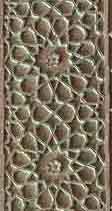REQUIRED
WORK:
*Veena
Talwar Oldenburg,"Lifestyle
as Resistance: The Case of the Courtesans of Lucknow," in Lucknow:
Memories of a City, ed. by Violette Graff (New Delhi: Oxford
University
Press, 1997), pp. 36-54: on
the CU website. Only the Graff version of the article is required
reading,
but if you're interested, here is *a
more detailed version*. (For more material, if you're still
interested, see the *Umrao Jan website*.)
*Juan R. I.
Cole, "Shi'ite
Noblewomen and Religious Innovation in Awadh," in Lucknow:
Memories
of a City, ed. by Violette Graff (New Delhi: Oxford University
Press,
1997), pp. 83-90: on
the CU website.
*Mushirul
Hasan, "Traditional
Rites and Contested Meanings: Sectarian Strife in Colonial
Lucknow,"
in
Lucknow:
Memories of a City, ed. by Violette Graff (New Delhi: Oxford
University
Press, 1997), pp. 114-133: on
the
CU website.
*Annemarie
Schimmel,
"Karbala and the Imam Husayn in Persian and Indo-Muslim Literature,"
from Al-Serat, Vol XII (1986):
on
the CU website.
*Maulana
Ashraf Ali Thanavi,
Perfecting Women, trans. Barbara D. Metcalf (Berkeley: Univ. of
Cal.
Press, 1990), The introduction, pp. 1-26: online
at CU; and Chapter 1 (in Book One) (pp. 64-78): these
pages online at CU. Also: online
through Netlibrary. Once within their system, you can go to the exact
location.
*Ismat
Chughtai, "The
Wedding Shroud,"
in
The Quilt and Other Stories, trans. by Tahira
Naqvi (Riverdale-on-Hudson, NY: Sheep Meadow Press, 1994), pp. 59-70.
At
Labyrinth; also, BUTLER RESERVE. If you'd like a look at a more literal
translation, here's my
own.
POSSIBLE
PAPER TOPIC TEN:
Ismat Chughtai's The
Quilt and Other
Stories contains some of the best stories by the first great
pioneer
of women's short-story writing in Urdu. Choose three other stories from
it (apart from "The Wedding Shroud") that you particularly admire, and
analyze them in terms of their social and cultural frames of reference.
How do the characters' specific circumstances (social class, kinship
networks,
marital arrangements, finances, activities, etc.) reflect some of the
larger
patterns and historical processes that we have been examining? Do the
stories
seem entirely realistic, or do they seem to be stylized, for didactic
or
other purposes?



